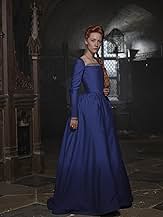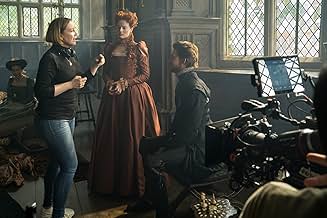A tentativa de Mary Stuart de derrubar sua prima Elizabeth I, rainha da Inglaterra, a encontra condenada a anos de prisão antes de enfrentar a execução.A tentativa de Mary Stuart de derrubar sua prima Elizabeth I, rainha da Inglaterra, a encontra condenada a anos de prisão antes de enfrentar a execução.A tentativa de Mary Stuart de derrubar sua prima Elizabeth I, rainha da Inglaterra, a encontra condenada a anos de prisão antes de enfrentar a execução.
- Indicado a 2 Oscars
- 8 vitórias e 31 indicações no total
- Direção
- Roteiristas
- Elenco e equipe completos
- Produção, bilheteria e muito mais no IMDbPro
Avaliações em destaque
It's only my love for Saoirse Ronan and Adrian Lester that I kept it on. It was Disney-fied in the casting area as there were no people of colour as nobleman or indeed in the court at that time. Mary's accent is not accurate as she was raised in France. And they didn't all wear black. It was like rowan atckinson's black adder. The subject matter is intense as extreme misogyny meets religious hypocrisies! Well
Shot and acted by ALL.
Somebody else already called this film the "woke" version, and I would have to agree. A black counselor for Mary? An Asian noble woman in the English court? Wherever would they come from? It's not like you could jump on a plane and be anywhere in no time in 1565 And if you could, that you would be accepted when you got there.. Rizzio, Mary's secretary, and Darnley, Mary's second husband, gay? I have actually heard rumors and seen productions about Darnley maybe being bisexual as far back as the 1970s, but at the time, to be homosexual was a crime punishable by death. I doubt that Mary the Catholic queen was so "with it" that she would consider Rizzio, here portrayed as openly gay, just one of her gang of ladies in waiting.
I'm just surprised there wasn't a Hispanic in the cast. I'm sure that they wanted to include one, but the new world had hardly been explored at all by the 1560s so, nope, not even these producers would go that far. Oh, and Elizabeth and Mary never met, and Elizabeth was basically tricked into signing Mary's death warrant.
Is it an interesting tale well told? I thought so. If this was an extension of Game of Thrones, or some other such fantasy drama that was only loosely tethered to the Middle Ages as it existed in Europe, it would have worked. But not as a historical drama. I will say the art design and cinematography were beautiful.
I'm just surprised there wasn't a Hispanic in the cast. I'm sure that they wanted to include one, but the new world had hardly been explored at all by the 1560s so, nope, not even these producers would go that far. Oh, and Elizabeth and Mary never met, and Elizabeth was basically tricked into signing Mary's death warrant.
Is it an interesting tale well told? I thought so. If this was an extension of Game of Thrones, or some other such fantasy drama that was only loosely tethered to the Middle Ages as it existed in Europe, it would have worked. But not as a historical drama. I will say the art design and cinematography were beautiful.
I really wanted to love this movie. It was beautifully shot, and Ronin was, as always, very strong. And the rest of the cast was fine -- the problems with this Elizabeth were not Robbie's fault. The film was beautiful, but quite, quite dead. And it didn't flow, just a bunch of independent set pieces. Blame the writer and the director.
This film tells the story of Mary Stuart, the queen of Scotland int eh 1500's.
Within fifteen minutes into the film, I already lost all interest in it. The fact that the Royal Court is multi-ethnic back then is unimaginable and inaccurate, even to a person who knows only basic world history. Then, Mary addresses an effeminate man as sister? Really? Homosexuality was punishable by death those days. The story is slow most of the time, but critical plot points are just skimmed over. The fact that the supporting characters are mostly unrecognisable (except for Guy Pearce) makes the characters very confusing too. I can hardly tell who is who. It is a huge bore and a big disappointment.
Within fifteen minutes into the film, I already lost all interest in it. The fact that the Royal Court is multi-ethnic back then is unimaginable and inaccurate, even to a person who knows only basic world history. Then, Mary addresses an effeminate man as sister? Really? Homosexuality was punishable by death those days. The story is slow most of the time, but critical plot points are just skimmed over. The fact that the supporting characters are mostly unrecognisable (except for Guy Pearce) makes the characters very confusing too. I can hardly tell who is who. It is a huge bore and a big disappointment.
Historic authenticity is cast to the wind in this revisionist costume drama that feels like it was written by a freshman Women's Studies major. Directed by Josie Rourke with a screenplay by Beau Willimon, Mary Queen of Scots (2018) was based on the book Queen of Scots: The True Life of Mary Stuart by John Guy. Like many films released this year, it has strong female leads, a diverse cast, and progressive social messaging, but checking all the right boxes on the SJW playlist wasn't enough to save this film from mediocrity.
The year is 1560, and the young and beautiful Mary Tudor (Saoirse Ronan) returns home, where she is out of place in a dreary Scottish castle. Her half-brother, James, Earl of Moray (James McArdle), has been ruling as regent, alongside a bevy of colorless and perpetually-angry Protestant men. Her appearance in Scotland alarms her cousin, Queen Elizabeth I of England (Margot Robbie). Elizabeth, a Protestant, is not seen as a legitimate ruler by her Catholic subjects. She seeks to gain influence over Mary by arranging a marriage with Elizabeth's own lover, Robert Dudley (Joe Alwyn).
Instead, Mary marries the charming and charismatic Lord Henry Darnley (Jack Lowden), who pulls a Jeckyll-and-Hyde routine and becomes a drunken lecher on their wedding night. Things get complicated for the childless Queen Elizabeth when Mary becomes pregnant, producing an heir for her dynasty and strengthening her claim to the English throne. Can Mary fend off attacks from her domestic critics and convince Elizabeth to acknowledge her as England's rightful ruler?
Mary Queen of Scots couldn't decide whether it wanted to be a film about the rivalry between two queens or a revisionist biopic of its titular character, so it does neither particularly well. This ill-conceived and poorly executed film also missed a chance to let its leading ladies shine. As Queen Elizabeth, the talented Margot Robbie goes to waste as a costumed mannequin who practically disappears for the middle third of the film.
Historically, Mary Stuart was born in 1542, the only legitimate heir to Scottish King James V. She was briefly married to the King of France. After his untimely death in 1560, Mary returned to Scotland and ruled as Mary I of Scotland until 1567, when she was forced to abdicate after her second husband's murder (which her rivals accused her of orchestrating). She fled to England to seek protection from her cousin, Queen Elizabeth I, but many English Catholics considered Mary the legitimate Queen of England, so Elizabeth had her imprisoned and later executed.
There are many anachronisms and inaccuracies throughout Mary Queen of Scots, not the least of which was "colorblind casting" that falsely portrays 16th-Century England and Scotland's aristocracy as racially diverse. Mary's Scottish accent was also out of place (she grew up in France), as was her friendship with Italian courtier David Rizzio/Riccio. Most historians acknowledge Mary was probably having an affair with the man, which infuriated her Second Husband. Rizzio might have been bisexual, but he wasn't "one of the girls," as the film portrays.
Though ostensibly based on a book, this film can be considered a remake of the 1971 film by the same name. Mary, Queen of Scots (1971) was directed by Charles Jarrott and starred Vanessa Redgrave and Glenda Jackson. Like the 2018 film, the 1971 version featured a fictional meeting between the two queens and speculated that Lord Darnley and the musician David Riccio were lovers. The two films part ways, however, when it came to Mary's imprisonment. The 1971 version devotes more screen time to her 19 years in English captivity, while this version fast-forwards through it.
Mary Queen of Scots opened to mixed reviews and currently holds a 63% positive rating from critics and 44% audience favorability on RottenTomatoes. Its opening weekend took in a painful $194,777 on a $25 million budget. A successful film gets the audience invested in the story. Mary Queen of Scots ultimately failed to connect with audiences because it was more concerned with pushing the filmmaker's social perspective than making us care about who gains the English throne.
The year is 1560, and the young and beautiful Mary Tudor (Saoirse Ronan) returns home, where she is out of place in a dreary Scottish castle. Her half-brother, James, Earl of Moray (James McArdle), has been ruling as regent, alongside a bevy of colorless and perpetually-angry Protestant men. Her appearance in Scotland alarms her cousin, Queen Elizabeth I of England (Margot Robbie). Elizabeth, a Protestant, is not seen as a legitimate ruler by her Catholic subjects. She seeks to gain influence over Mary by arranging a marriage with Elizabeth's own lover, Robert Dudley (Joe Alwyn).
Instead, Mary marries the charming and charismatic Lord Henry Darnley (Jack Lowden), who pulls a Jeckyll-and-Hyde routine and becomes a drunken lecher on their wedding night. Things get complicated for the childless Queen Elizabeth when Mary becomes pregnant, producing an heir for her dynasty and strengthening her claim to the English throne. Can Mary fend off attacks from her domestic critics and convince Elizabeth to acknowledge her as England's rightful ruler?
Mary Queen of Scots couldn't decide whether it wanted to be a film about the rivalry between two queens or a revisionist biopic of its titular character, so it does neither particularly well. This ill-conceived and poorly executed film also missed a chance to let its leading ladies shine. As Queen Elizabeth, the talented Margot Robbie goes to waste as a costumed mannequin who practically disappears for the middle third of the film.
Historically, Mary Stuart was born in 1542, the only legitimate heir to Scottish King James V. She was briefly married to the King of France. After his untimely death in 1560, Mary returned to Scotland and ruled as Mary I of Scotland until 1567, when she was forced to abdicate after her second husband's murder (which her rivals accused her of orchestrating). She fled to England to seek protection from her cousin, Queen Elizabeth I, but many English Catholics considered Mary the legitimate Queen of England, so Elizabeth had her imprisoned and later executed.
There are many anachronisms and inaccuracies throughout Mary Queen of Scots, not the least of which was "colorblind casting" that falsely portrays 16th-Century England and Scotland's aristocracy as racially diverse. Mary's Scottish accent was also out of place (she grew up in France), as was her friendship with Italian courtier David Rizzio/Riccio. Most historians acknowledge Mary was probably having an affair with the man, which infuriated her Second Husband. Rizzio might have been bisexual, but he wasn't "one of the girls," as the film portrays.
Though ostensibly based on a book, this film can be considered a remake of the 1971 film by the same name. Mary, Queen of Scots (1971) was directed by Charles Jarrott and starred Vanessa Redgrave and Glenda Jackson. Like the 2018 film, the 1971 version featured a fictional meeting between the two queens and speculated that Lord Darnley and the musician David Riccio were lovers. The two films part ways, however, when it came to Mary's imprisonment. The 1971 version devotes more screen time to her 19 years in English captivity, while this version fast-forwards through it.
Mary Queen of Scots opened to mixed reviews and currently holds a 63% positive rating from critics and 44% audience favorability on RottenTomatoes. Its opening weekend took in a painful $194,777 on a $25 million budget. A successful film gets the audience invested in the story. Mary Queen of Scots ultimately failed to connect with audiences because it was more concerned with pushing the filmmaker's social perspective than making us care about who gains the English throne.
Você sabia?
- CuriosidadesThe first time Saoirse Ronan and Margot Robbie saw each other in character was during the scene where they meet for the first time. They rehearsed separately, and Robbie's scenes were completed the day Ronan began hers.
- Erros de gravaçãoDarnley wasn't exiled to Kirk o' Field, he was sent there with the pox, for medical quarantine.
- ConexõesFeatured in Front Row: Episode #3.3 (2018)
Principais escolhas
Faça login para avaliar e ver a lista de recomendações personalizadas
- How long is Mary Queen of Scots?Fornecido pela Alexa
- Is this fiction or history?
Detalhes
- Data de lançamento
- Países de origem
- Centrais de atendimento oficiais
- Idiomas
- Também conhecido como
- Las dos reinas
- Locações de filme
- Aviemore, Highland, Escócia, Reino Unido(on location)
- Empresas de produção
- Consulte mais créditos da empresa na IMDbPro
Bilheteria
- Orçamento
- US$ 25.000.000 (estimativa)
- Faturamento bruto nos EUA e Canadá
- US$ 16.468.499
- Fim de semana de estreia nos EUA e Canadá
- US$ 194.777
- 9 de dez. de 2018
- Faturamento bruto mundial
- US$ 46.712.809
- Tempo de duração2 horas 4 minutos
- Cor
- Mixagem de som
- Proporção
- 2.39 : 1
Contribua para esta página
Sugerir uma alteração ou adicionar conteúdo ausente






































